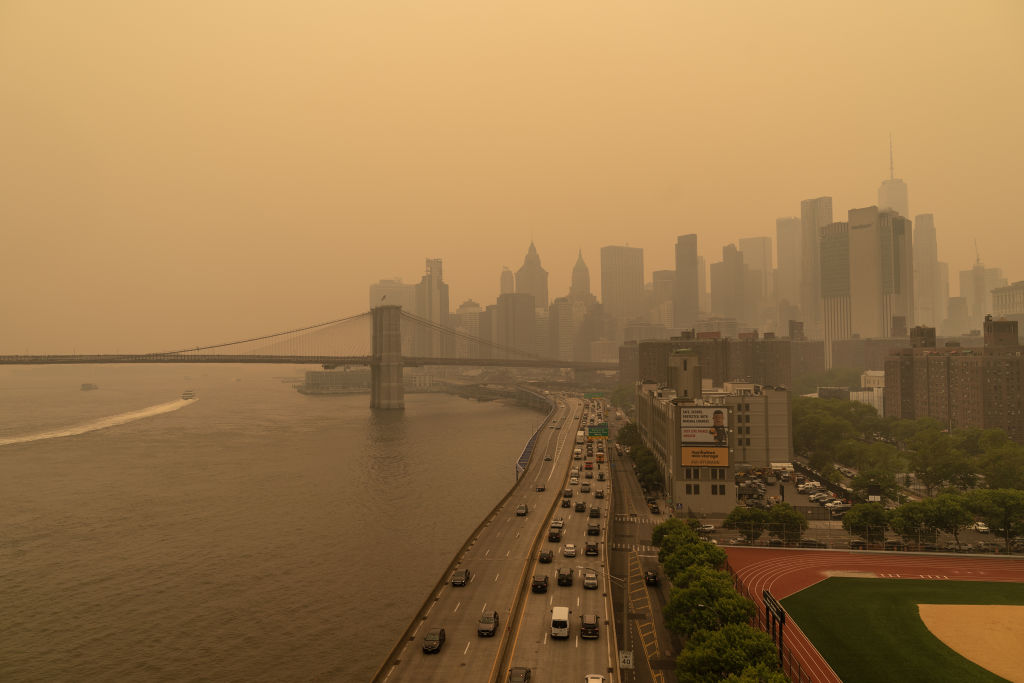Environmental Racism: Pollution From Canada Wildfires Exacerbates Existing Air Quality Inequities
Source: Anadolu Agency / Getty
Hidden in the guidance around the effects of wildfires in Canada and the hovering pollution it’s causing in the Northeast and Mid-Atlantic regions are the serious potential ramifications for people already living under the proverbial knee of environmental racism.
People living in those areas woke up Thursday to the worst air quality in the U.S. But what’s not being explicitly said is how those same areas are home to some of the largest concentrations of urban areas where a fair number of Black and brown people live.
Check out this almost unbelievable time-lapse of wildfire smoke consuming the World Trade Center and the New York City skyline.
Those vulnerable to poor air quality, including seniors and young children, should limit time outdoors if possible.
More: https://t.co/ChRuWv7X6E pic.twitter.com/mtKtLun8lN
— NWS New York NY (@NWSNewYorkNY) June 7, 2023
The element of race and ethnic background is important to this topic because statistics show that those same Black and brown people are disproportionately exposed to elevated levels or poor air quality out of the virtue of where they live — facts that have been attributed to serious health consequences like asthma and worse.
While the current air quality is affecting everyone exposed to it regardless of race or socio-economic status, data shows Black and brown communities bear the brunt of pollution year-round.
Seeing comparisons as wildfire smoke blankets the Northeast. Some folks don’t seem to realize many communities live in dangerous air everysingledayofentirelives due to environmental racism.
It’s intolerable, no?
The fossil fuel/toxic industry chokehold needs to end https://t.co/ixKQNycKq8
— Juliana Pino she | ella (@julianapino) June 7, 2023
What is environmental racism?
Defined as an environmental injustice that occurs within a racialized context both in practice and policy, the term environmental racism describes the disproportionate impact of environmental hazards on people of color. Higher air pollution and rising temperatures have always plagued communities of color, but so have a host of other issues, including but not limited to the various water crises we’ve seen in recent years.
Documented cases of environmental racism in the same U.S. areas which the Canadian wildfires are affecting have existed for decades. But beyond those regions, exposure to existing instances of environmental racism is typically based on socio-economic status. Because Black and brown people are on the lower rungs of that spectrum, many times they have little other point of recourse than to live in areas where there are high levels of pollution.
Citing statistics from the Environmental Protection Agency (EPA), the American Lung Association warned about respirratory health conditions like asthma and listed a number of factors that can contribute to such circumstances:
Low socioeconomic status consistently increased the risk of premature death from fine particle pollution among 13.2 million Medicare recipients studied in the largest examination of particle pollution-related mortality nationwide. In a 2008 study that found greater risk for premature death for communities with higher African American populations, researchers also found greater risk for people living in areas with higher unemployment or higher use of public transportation.
I wear my mask today in solidarity with the New Yorkers being impacted by the Canadian wildfires.
Is this the future we accept for our children? Climate change is not a hoax!
Join me in this fight for environmental justice for all. pic.twitter.com/YB9Rukt8UC
— Adriano Espaillat (@RepEspaillat) June 7, 2023
Not just poor people affected
Environmental racism is commonly misinterpreted as a problem that only plagues poor folks, but its effects on middle-class Black Americans have also been devastating. Landfills, power plants and waste management facilities commonly find their way into the majority of middle-class Black neighbors.
During a 2007 study, sociologist Robert Bullard found that race was a more accurate indicator of proximity to pollution than socioeconomic status. Bullard’s shocking revelation suggested that race was more important than income when predicting the location of the nation’s commercial hazardous waste facilities. He proved that Black Americans making $50,000 to 60,000 a year are more likely to live in a polluted neighborhood than their white counterparts making just $10,000 annually.
SEE ALSO:
EPA’s New Environmental Justice Office Pledges ‘Billions’ For ‘Those Who Need It The Most
Climate Justice For Black Futures: The Fight To Overcome The Legacy Of Environmental Racism
The post Environmental Racism: Pollution From Canada Wildfires Exacerbates Existing Air Quality Inequities appeared first on NewsOne.

